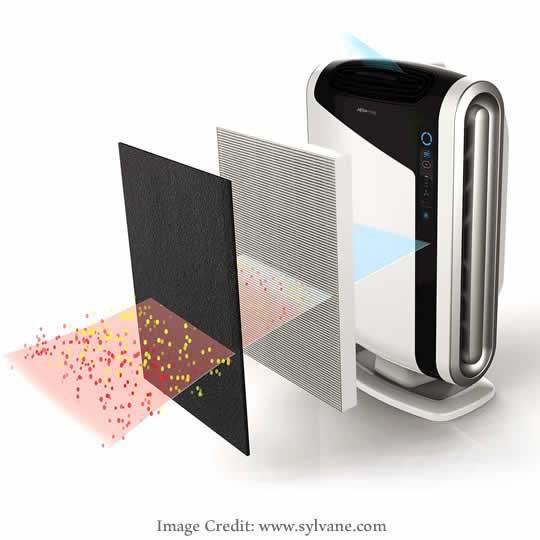What is an Air Purifier?
When it comes to maintaining a safe, healthy environment for a family to live in, keeping the air inside your home clean is important.
What is an air purifier and how does it work to satisfy that element of atmospheric cleanliness that we ought to enjoy in our homes?
This appliance cleans the air inside your house, eliminating all traces of smoke, pet dander, pollen, pollutants and odors.
Indoor air can have five times the amount of pollutants as outdoor air.
Many of these indoor pollutants can be neutralized by specially designed purifiers, which I shall take a look at here.
How Does an Air Purifier Work?
Filtering the Air
 An air purifier typically has a filter (or multiple filters) and a fan which circulates and sucking in the air.
An air purifier typically has a filter (or multiple filters) and a fan which circulates and sucking in the air.
Air moves through the filter and pollutants and particles are trapped. The clean air is pushed out into the environment.
Filters are usually made of paper, fiber, or mesh. They need to be regularly replaced in order to preserve their efficiency.
The type of purifier and its usage will affect how often you have to change filters. Although some filters are washable and reusable, they need to be cleaned regularly.
Reusable filters work well at removing larger particles, such as dust mites or pollen. UV (ultraviolet radiation) filters are also available. They claim to remove biological impurities, such as bacteria or mold, but they need higher wattage and more exposure to be effective.
Air Purifier Operating Cost
You should consider the operating and replacement costs of your air purifier as well as the purchase price.
Operating costs can easily run to $50 per annum, as you need to keep the air purifiers running nearly constantly in order to reap the benefits. All in all, filter replacements can run up to $100 per year.
Ionizers
Some air purifiers have ionizers that help attract particles, such as static. These ions form a negative bond to allergens and dust and settle out of air.
If you are considering buying an air purifier that uses ionizers, ensure it does not produce dangerous amounts of ozone. Ozone is a gas composed of three oxygen atoms.
It can cause lung irritation and worsen asthma symptoms. The ozone content of air purifiers will usually be listed on the packaging and in the marketing descriptions.
Our recommendation is to keep plasma/ionization functions off of units that have been subjected to additional testing until more industry standards are developed. This is due to unknown adverse consequences and increased energy usage.
What Do Purifiers Filter Out?
The majority of air purifier filters available on the market are intended to capture very small airborne particles like dust and pet dander.
Respiratory irritants such as pollen, the vapors from many chemical cleaning agents, aerosol sprays, furniture protectors and fire retardants are also removed from the air.
However, the regular filters fitted to most air purifiers won't catch gases such as VOCs (volatile organic compound) or Radon that can accumulate from adhesives paints or cleaning products. To trap these gases, filters containing an absorbent such as activated carbon is required and can be found on some higher end appliances.
According to the Environmental Protection Agency, purifiers have limited functionality in filtering out gases. Filters must be changed frequently for optimal functionality.
This is usually every three to six months. While purifiers remove many allergens and pollutants from the air, they won't capture allergens embedded in furniture and flooring.
Additional cleaning using vacuums fitted with HEPA filters are needed to remove such pollutants.
How Effective Are Air Purifiers ?
In real-world environments, air purifiers won't perform as well as in lab conditions. It will depend on the environment, the type of purifier, the flow rate, and the time it takes to work.
You should also consider other factors such as ventilation (open or close windows), and the possibility of new particles emerging. This could affect the efficiency of the air filter.
You can use disinfectant cleaners or effective vacuums to get rid of any bacteria, viruses, and allergens that may have settled on surfaces.
Summary
The main goal of running an air purifier is to maintain a good level of clean air that circulates around your home.
These devices are particularly good at filtering out airborne pollutants and respiratory irritants that can have an impact on our health.
While they may not remove every unwanted particulate from the air such as certain gases, they do a very good job of removing most of what can have a negative impact on health.
Posted: March 19, 2022
[Back to Top]